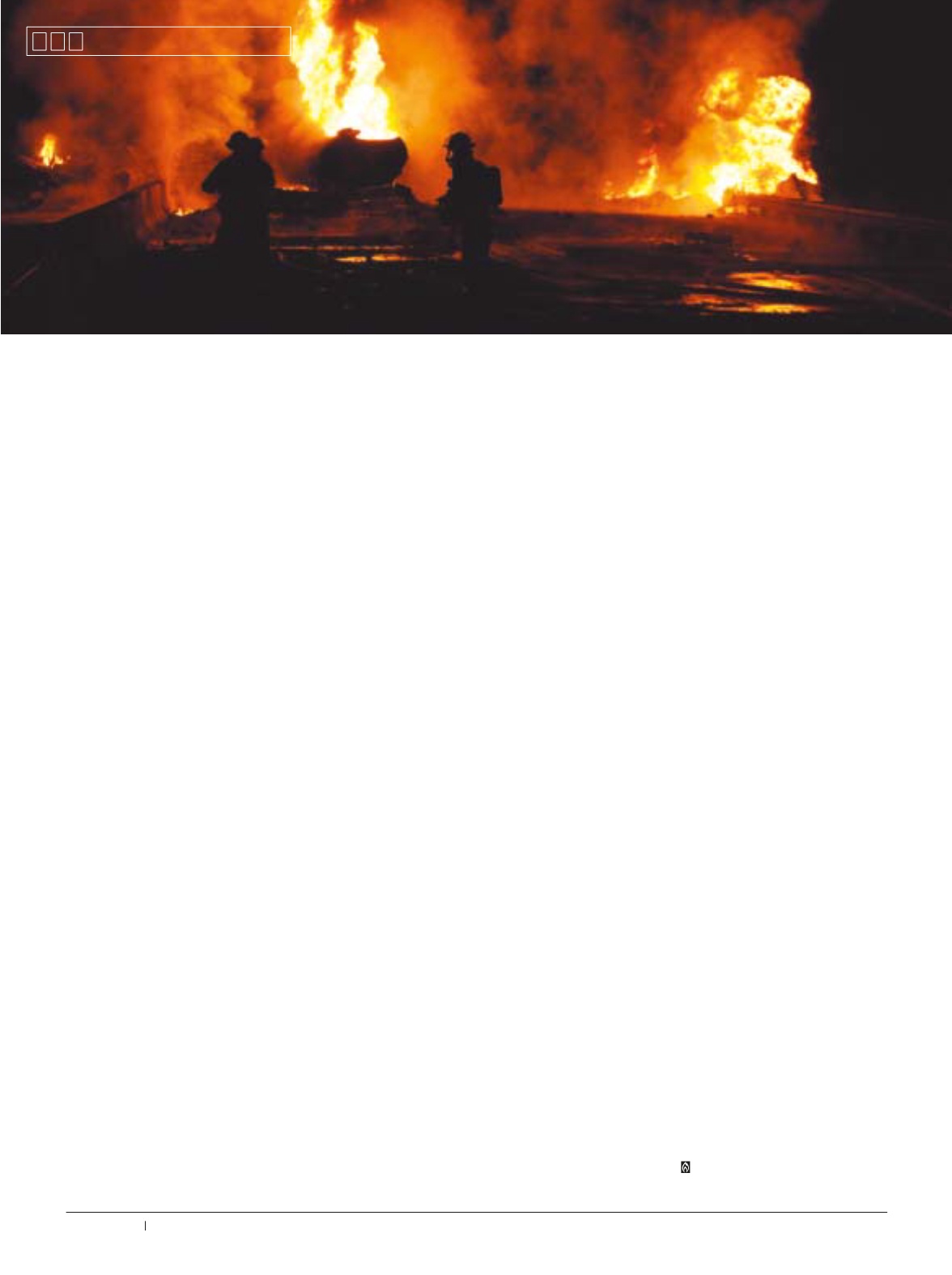
34 • OIL
&
ENERGY
Safety
SAFETY CONCERNS WITH THE OIL-BY-RAIL
boom continue to make headlines. In July,
an unattended runaway train loaded with
50,000 barrels of crude oil derailed and
exploded, killing 47 people and devastating
the small Canadian town of Lac-Megantic.
Officials are trying to determine how
the train’s five engines and 72 tank cars
rolled out of a small rail yard and several
miles down an incline into the town.
Investigators are focusing on a fire that
broke out on the lead locomotive just hours
before the derailment. It’s unclear what role
that fire may have played in the derailment,
or whether efforts to put out the fire could
have affected the train’s brakes.
With much of their downtown
destroyed, the town of Lac-Megantic is
cleaning up the massive mess left behind.
Most people understand the need to ship oil
by rail, but there are questions as to whether
enough safeguards are in place.
So how can a company measure how
well their safety program is working? A
good rule of thumb is: “If your program is
handling issues proactively, it’s working. If
you’re handling these same issues reactively,
it’s probably not.”
HIRING THE RIGHT DRIVERS
When you think about end-to-end safety
procedures, it really begins with hiring prac-
tices, and how safety history plays a major
role in the prescreening process. It’s also a
good idea to start the process with docu-
mented qualifications and hiring policies.
We want to do whatever we can to hire
the right person for the job. As an example,
applicants for driving positions would go
through a rigorous pre-screening process
before they started with interviews.
You would run background checks,
review their driving records, along with
pre-employment drug and alcohol testing.
You can also check on a driver’s accident
history and roadside inspection history
through the DOT’s Pre Employment
Screening Program website. Then come the
interviews, and once everything checks out
okay, the applicant would then be required
to pass a road test.
So how do you find the best drivers?
Although social media is growing as a
recruitment tool, your best source for good
candidates may come from a driver’s referral
bonus program. Your staff recognizes the
caliber of drivers you’re looking for. They
understand the policies and safety culture,
and whether a person might be a good fit
for your company.
Keep in mind, the top three things that
applicants for driver positions say they’re
looking for are: competitive pay scale; good
medical benefits; and an opportunity to run
newer equipment.
THEN THERE’S TRAINING
How much time can you dedicate to
ensure that the new driver understands the
job and procedures?
For most companies, assigning a senior
driver or trainer with new drivers during a
15-day documented program is an effective
way to evaluate the driver. They go through
the entire process, getting familiar with
the vehicle, learning about the different
products, how to load the truck and unload
the trucks. They also get familiar with pro-
cedures, customer sites, and working with
the dispatchers.
ESTABLISH AND REVISIT POLICIES
Written policies should provide clear
guidance with issues and procedures that
staff should be familiar with, for example:
• Distracted driving policy
• Drug and alcohol testing policy
• Emergency breakdown and road call
procedures
• Vehicle safety and compliance policy
• 90 percent capacity fill policy
• Pre-trip and post-trip inspections
policy
• Hours of service and logs policy.
RECOGNITION AND REWARD
Whether your company offers cash
bonuses, extra vacation time, or a pair of
movie tickets, it’s important to recognize
individuals who do their job safely and keep
the company in compliance. Barbecues and
pizza parties are a great way to recognize the
group for reaching company safety goals.
THE MORTAL SINS
Set the ground rules. Establish a list of
safety violations that require corrective or
disciplinary actions. For example, serious
offenses that a driver could be terminated
for might include: leaving the valve unat-
tended while transferring product; failure
to use vapor recovery when required; or
failing a drug test. Time-off violations might
include: small product releases, contamina-
tion of product, etc.
PERMITS, CODES AND REGULATIONS
From local ordinances to federal man-
dates, we certainly have a lot of compliance
to manage. With that said, keeping your
business in compliance helps you avoid
fines, lower insurance premiums, and
maintain better community relations.
KEY PERFORMANCE INDICATORS
To gauge how well your safety program
is doing, you can look for lower insurance-
loss ratios, fewer workers comp claims,
better Department of Transportation
(DOT) Compliance, Safety, Accountability
(CSA) and Occupational Safety and Health
Administration (OSHA) MOD scores, etc.
In a good safety program, it’s about the
sharing experience, and what the staff brings
to the table. It’s about listening to newer
drivers speaking up at safety meetings with
questions about situations that may have
come up. Then hearing senior drivers draw
on their experiences, talk it through, and
almost always have good advice for doing
the job correctly – with safety as their top
priority.
Making Safety Programs More Effective
By Ed Burke, Dennis K. Burke Inc.


